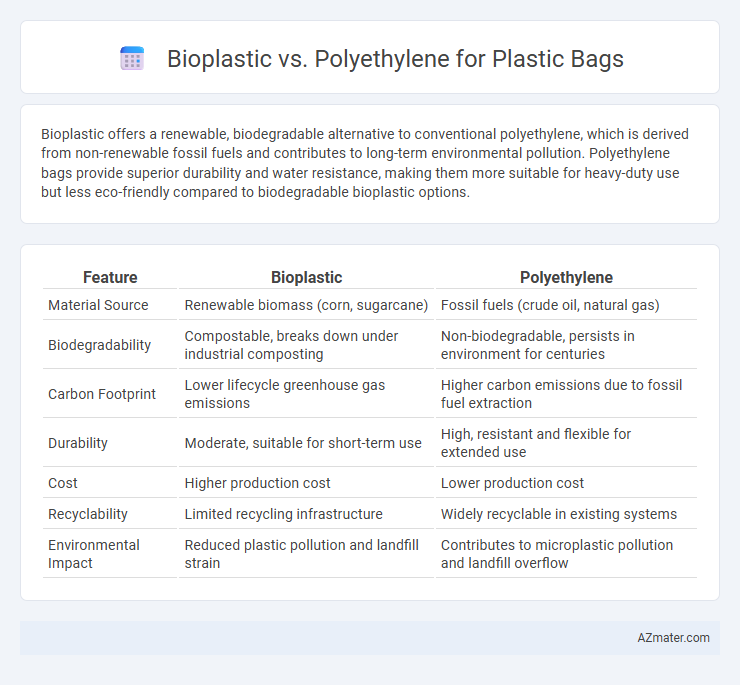Bioplastic offers a renewable, biodegradable alternative to conventional polyethylene, which is derived from non-renewable fossil fuels and contributes to long-term environmental pollution. Polyethylene bags provide superior durability and water resistance, making them more suitable for heavy-duty use but less eco-friendly compared to biodegradable bioplastic options.
Table of Comparison
| Feature | Bioplastic | Polyethylene |
|---|---|---|
| Material Source | Renewable biomass (corn, sugarcane) | Fossil fuels (crude oil, natural gas) |
| Biodegradability | Compostable, breaks down under industrial composting | Non-biodegradable, persists in environment for centuries |
| Carbon Footprint | Lower lifecycle greenhouse gas emissions | Higher carbon emissions due to fossil fuel extraction |
| Durability | Moderate, suitable for short-term use | High, resistant and flexible for extended use |
| Cost | Higher production cost | Lower production cost |
| Recyclability | Limited recycling infrastructure | Widely recyclable in existing systems |
| Environmental Impact | Reduced plastic pollution and landfill strain | Contributes to microplastic pollution and landfill overflow |
Introduction to Bioplastic and Polyethylene
Bioplastic is a renewable alternative made from plant-based materials like corn starch or sugarcane, designed to reduce environmental impact through biodegradability. Polyethylene, a petroleum-derived polymer, dominates plastic bag production due to its durability, flexibility, and low cost. Understanding the chemical composition and environmental footprint of both materials is essential for evaluating sustainable packaging options.
Chemical Composition and Structure
Bioplastic bags are primarily composed of renewable biomass sources such as corn starch, cellulose, or polylactic acid (PLA), which feature a polymer matrix derived from natural monomers, resulting in biodegradable and compostable characteristics. Polyethylene bags consist of long chains of ethylene monomers, forming a synthetic polymer with high molecular weight, characterized by a non-polar, hydrocarbon structure that provides durability and resistance to moisture. The chemical structure of bioplastics allows enzymatic decomposition, while polyethylene's saturated hydrocarbon backbone leads to persistence in the environment due to its chemical inertness.
Production Processes
Bioplastic production involves renewable raw materials such as cornstarch or sugarcane, undergoing fermentation or polymerization to create biodegradable polymers like polylactic acid (PLA). Polyethylene, a conventional plastic, is synthesized from petroleum-derived ethylene monomers through high-pressure polymerization in processes like radical or Ziegler-Natta catalysis. The differing feedstocks and chemical pathways in bioplastic and polyethylene production critically impact environmental footprints and end-of-life degradation capabilities.
Raw Material Sources
Bioplastic bags are primarily derived from renewable biomass sources such as corn starch, sugarcane, and tapioca roots, offering a sustainable alternative to petroleum-based products. Polyethylene bags are produced from crude oil and natural gas, relying on finite fossil fuel reserves with significant environmental impacts. The use of bioplastics reduces dependency on fossil fuels and contributes to lower greenhouse gas emissions during raw material extraction.
Biodegradability and Environmental Impact
Bioplastic bags, derived from renewable biomass sources such as corn starch or sugarcane, exhibit enhanced biodegradability compared to traditional polyethylene bags, which are petroleum-based and persist in the environment for centuries. Polyethylene's resistance to microbial degradation contributes significantly to plastic pollution, whereas bioplastics can break down under industrial composting conditions, reducing landfill accumulation and oceanic microplastic formation. The environmental impact of bioplastics is further minimized by lower greenhouse gas emissions during production, although the need for specialized composting facilities limits their overall degradation efficiency in natural settings.
Performance and Durability
Bioplastic bags, derived from renewable resources like cornstarch, offer biodegradability but often lack the tensile strength and durability of polyethylene bags, which are made from petrochemicals. Polyethylene bags exhibit superior resistance to punctures and tearing, making them more reliable for heavy-duty uses and longer shelf life. Performance-wise, polyethylene maintains flexibility and moisture barrier properties under diverse conditions, whereas bioplastic bags may degrade prematurely when exposed to humidity or mechanical stress.
Cost Analysis and Market Availability
Bioplastic bags generally have higher production costs compared to polyethylene bags, driven by the expense of raw materials like cornstarch and the complexity of manufacturing processes. Polyethylene remains more cost-effective and widely available, accounting for over 90% of plastic bag market share due to its low price and established supply chains. Market availability of bioplastics is increasing, with a projected CAGR of around 15% from 2023 to 2030, but polyethylene's dominance is sustained by affordability and extensive distribution networks.
Recycling and End-of-Life Options
Bioplastic bags typically offer compostable or biodegradable end-of-life options, breaking down under industrial composting conditions, while polyethylene bags primarily require mechanical recycling but often face contamination and low recovery rates. The recycling infrastructure for polyethylene is more established, enabling higher rates of material reclamation, though plastic bag contamination can cause operational challenges in recycling facilities. Bioplastics may reduce landfill accumulation but often need specialized facilities, whereas polyethylene's durability supports multiple reuse cycles before recycling or disposal.
Regulatory and Industry Standards
Bioplastic bags are increasingly compliant with international regulations such as ASTM D6400 and EN 13432 for compostability, while polyethylene bags primarily adhere to requirements set by the Plastics Industry Association and meet standards for recyclability under ASTM D7611. Regulatory bodies like the European Union's Single-Use Plastics Directive promote bioplastics to reduce environmental impact, whereas polyethylene remains prevalent due to established recycling infrastructures and cost-effectiveness. Industry standards emphasize labeling, biodegradability, and carbon footprint, driving manufacturers to innovate within both material categories to meet sustainability targets and legal mandates.
Future Trends and Innovations
Bioplastic development focuses on enhancing biodegradability and reducing carbon footprints compared to conventional polyethylene bags, which dominate current markets due to cost-efficiency and durability. Innovations in enzymatic degradation and the integration of plant-based polymers are driving the transition towards sustainable packaging solutions, promising faster decomposition cycles and improved environmental impact. Future trends indicate a growing adoption of compostable bioplastics in retail sectors, supported by regulatory incentives and advances in material science that improve performance parity with polyethylene.

Infographic: Bioplastic vs Polyethylene for Plastic Bag
 azmater.com
azmater.com